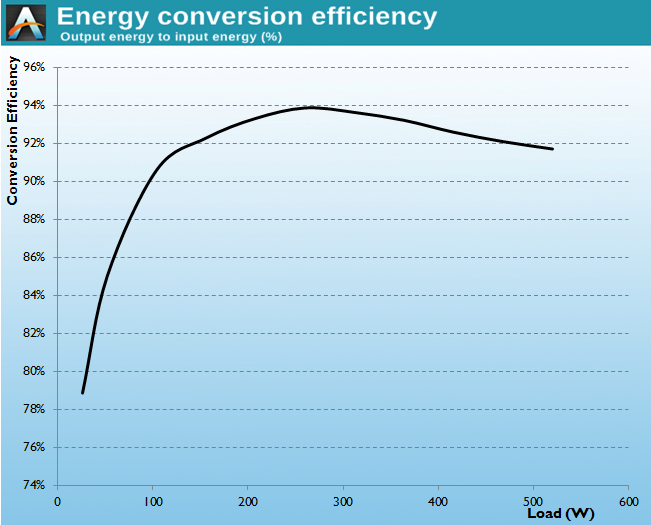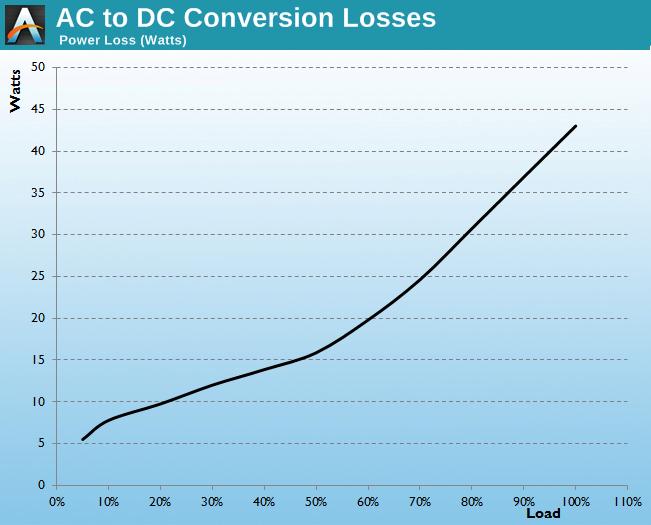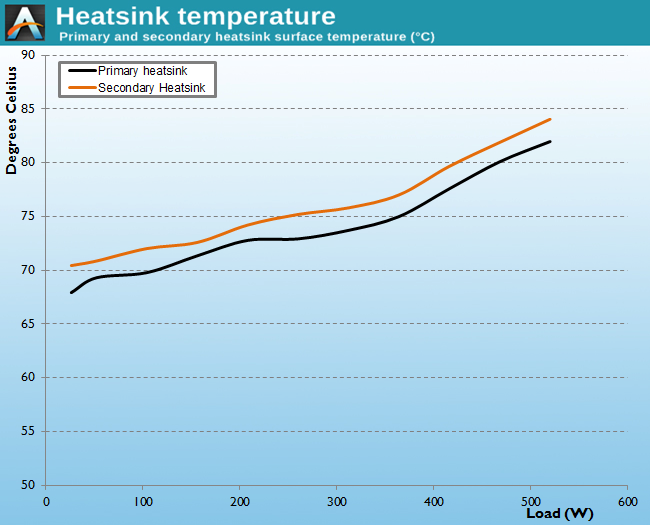SilverStone NightJar NJ520 Power Supply Review
by E. Fylladitakis on July 8, 2014 6:00 AM EST- Posted in
- Cases/Cooling/PSUs
- Seasonic
- PSUs
- Fanless
- SilverStone
Hot Test Results
From the tables below, it can be seen that the output power quality of the Silverstone Nightjar NJ520 is exceptional. The maximum voltage ripple that our instrumentation recorded was 34 mV under maximum load. Even with the unit heavily cross-loaded, the ripple on the 12V line only went up to 46 mV, which is much lower than the 120 mV design limit. Voltage regulation is less than 1% for the 12V line and just over 1.2% for the minor lines, performance figures that are excellent and comparable only to those of top-tier products.
| Main Output | ||||||||
| 104,72 W | 261,07 W | 389,82 W | 518,27 W | |||||
| 20,14% | 50,21% | 74,97% | 99,67% | |||||
| Line | Amperes | Volts | Amperes | Volts | Amperes | Volts | Amperes | Volts |
| 3.3 V | 3.05 | 3.34 | 7.62 | 3.33 | 11.44 | 3.32 | 15.25 | 3.30 |
| 5 V | 3.05 | 5.05 | 7.62 | 5.04 | 11.44 | 4.99 | 15.25 | 4.98 |
| 12 V | 6.56 | 12.07 | 16.39 | 12.03 | 24.59 | 11.99 | 32.79 | 11.96 |
| Line | Regulation (20% to 100% load) | Voltage Ripple (mV) | |||||
| 20% Load | 50% Load | 75% Load | 100% Load | CL1 12 V | CL2 3.3 V + 5 V | ||
| 3.3 V | 1.20% | 6 | 8 | 8 | 10 | 8 | 16 |
| 5 V | 1.45% | 10 | 12 | 16 | 16 | 10 | 18 |
| 12 V | 0.92% | 14 | 18 | 26 | 34 | 46 | 16 |
Although this unit is rated for operation with an ambient temperature of up to 40 °C, it performed just fine even with an ambient temperature of 50 °C. The energy conversion efficiency is reduced by about 0.4%, a fantastic result for increasing ambient temperature by 25 °C.
As the Nightjar NJ520 has no fan, the increase in ambient temperature essentially increases the operating temperature of the unit almost proportionally. The temperature of the primary and secondary side heatsinks is now reaching up to 81.9 °C and 84.1 °C respectively, figures that would make us feel uncomfortable but are not high enough to trigger a thermal shutdown by the protective circuit of the unit. The Nightjar NJ520 will simply shut down if overheated, as it has no active cooling and thus it cannot take any action to change its thermal performance. Obviously it's not really intended to be run in such extreme conditions, so plan accordingly.













44 Comments
View All Comments
houkoholic - Wednesday, July 9, 2014 - link
The usual good silent case with the right padding are also big. My last two silent cases were the famed Antec P180/182. Sure they were silent but they were nearly full tower size huge, I simply have no need for so much space in my current lifestyle when all I need in my build that isn't already on the motherboard is nothing more than a SSD, a single data storage HDD and one GPU.Recently I build a small micro-ITX build using the Antec ISK600 case, the shell of that case is just thin aluminium with no sound proofing unlike the P180s. So I put in a fanless PSU in there, threw out the Intel cooler for a Noctua tower cooler which runs a 120mm fan, the included case fan was good enough to be near silent thus my only component which makes any sort of whirling noise now is the the GPU stock cooler. In the end my build is silent and its footprint is small enough that I can put it on a bookshelf right next to my ears yet it is powerful enough for gaming. My total fan count in the build is 3 instead of 4, and one less fan is still one less component to worry about contributing to noise.
houkoholic - Wednesday, July 9, 2014 - link
One less part contributing to the noise can still factor in. Any fan could be victum to dust and wear which causes it to start making noise (happened to me a few times with PSU). If I have to pay for the privelage such that I don't have to clean my PSU fan as well, so be it, and that already has a point for its existence - and I suspect that there are enough people out there thinking the same to justify the existence of such products.dishayu - Wednesday, July 9, 2014 - link
This will go really well with my reference design R9 290. :Dsheh - Wednesday, July 9, 2014 - link
Thanks for the review!A request: Can you start testing PSUs at specific load (or draw) wattages instead of percentages, and go lower than 50W? Percentages arne't very meaningful by themselves, and watts can be compared directly. And watt-wise, modern computers under light load take less than 50W. Much less, actually. So 20% of this PSU might be what a modern computer draws at maximum CPU load.
mapesdhs - Wednesday, July 9, 2014 - link
I agree, I think my gateway uses about 30W or so.
Ian.
E.Fyll - Wednesday, July 9, 2014 - link
Actually no, because that is beyond the testing guidelines. 20% is the minimum acceptable testing limit for switching PSU power quality tests. It would also be meaningless to test a 1000 Watt unit at 50 Watt; that only implies that this unit should not have been there in the first place.Switching PSUs are inherently not capable of efficient operation at very low loads. It is worse to have a far too powerful PSU rather than a heavily loaded PSU.
torp - Thursday, July 10, 2014 - link
Testing guidelines be damned. A modern desktop idles at 40 W or less. I don't care what the specifications say, I want to know the efficiency in real world conditions. It's not like you can buy sub 500 W PSUs any more... with the lone exception of Seasonic's G360... if still available.sheh - Thursday, July 10, 2014 - link
400-450W are rather common, and maybe some <400W as well. But I think what's more pertinent is that span of loads in modern computers is larger than it used to be. CPUs and graphics cards have better dynamic power management and are more efficient in general, but you also have graphics cards with extreme power draws under load, and sometimes multiple cards in one system.sheh - Thursday, July 10, 2014 - link
Isn't the 20% thing just an old decision by Ecos Consulting? I guess even a modern tri-SLI system will use <100W on light desktop load.versesuvius - Thursday, July 10, 2014 - link
Underclocking is the word. It is also a good idea. A true enthusiast's wonderful scheme. Want a stable, reliable, quite system? Pay as much as is possible and then underclock, cpu, gpu, ram. For power supply this model has done it for you already out of the box. Better yet, buy a 1600 watt unit, which almost always uses no fan above 600 watts and you are even better set.